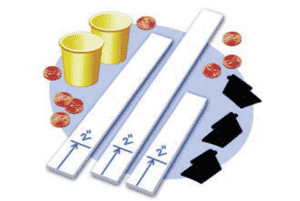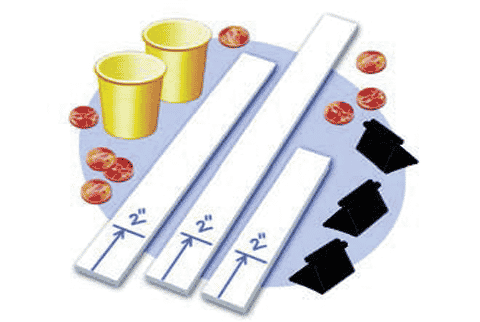Overview
STEM careers
Grade level
Time
Materials
Per Class:
|
Per Group of 4-5 Students:
|
Instructions
This activity gives students a chance to find out how foam board levers of differing lengths can lift differing numbers of pennies according to a predictable mathematical pattern.
PREPARATION:
Make the foam board strips by measuring and cutting a 20″x12″ piece of 1⁄4″ foam board. Measure 2″ from one end of each of the 3 strips and mark the fulcrum point. To make room for error, figure one piece of foam board for every 3 groups.
- Divide class into groups. Discuss the varying lengths of the lever arms and how levers work, using the terms fulcrum, load end, effort end, and lever arm throughout the activity. If nobody mentions it, point out that the 12″ lever arm is 2x as long as the 6″ lever arm, and the 18″ lever arm is 3x as long.
- Tell groups to set the shortest lever on the fulcrum. Put 1 penny in the cup; explain that it represents the downward push they will use to lift a load of pennies on the load end.

- Tell kids to put pennies in the load end until the lever tips down. To see how many pennies the load can lift, take them out until the load end lifts again and count the number of pennies in the cup.
- Repeat steps 2 and 3 with the other 2 levers. Record results on chart or board.
Guiding questions
-
Do you see a pattern with how the numbers in the results change? (Doubling the length of the lever should roughly double the number of pennies you can lift.)
-
What would happen if you changed the location of the fulcrum?
-
A lever is a type of machine. Can you think of another machine that could reduce the amount of work required to lift something?
Engineering & science connections
- The fulcrum is the point on which a lever rests. The lever arm is the foam board—the length of material that weight is placed on. The load end of the lever is the end that the weight is placed on. The effort end of the lever is the end that gets pushed down on to make the other end rise.
- The lever is a type of simple machine. Other simple machines include the pulley, inclined plane, and wedge. Simple machines are used to make work easier, such as when industrial cranes use pulleys and levers to lift very heavy loads.
- Engineers have adapted levers to lift all kinds of heavy objects, such as car jacks, cranes, and hydraulic lifts.
- Engineers pay attention to mathematical patterns in order to solve problems, such as determining the best place to put the fulcrum for diving boards, seesaws, and even hammers.
CYBERCHASE is produced by Thirteen/WNET New York in association with Title Entertainment Inc. Major Funding for CYBERCHASE is provided by the National Science Foundation, Ernst & Young LLP, Northrop Grumman Corporation, PBS and the Corporation for Public Broadcasting. Additional funding is provided by The Volckhausen Family. CYBERCHASE © 2008 Educational Broadcasting Corporation. All Rights Reserved.


0 Comments